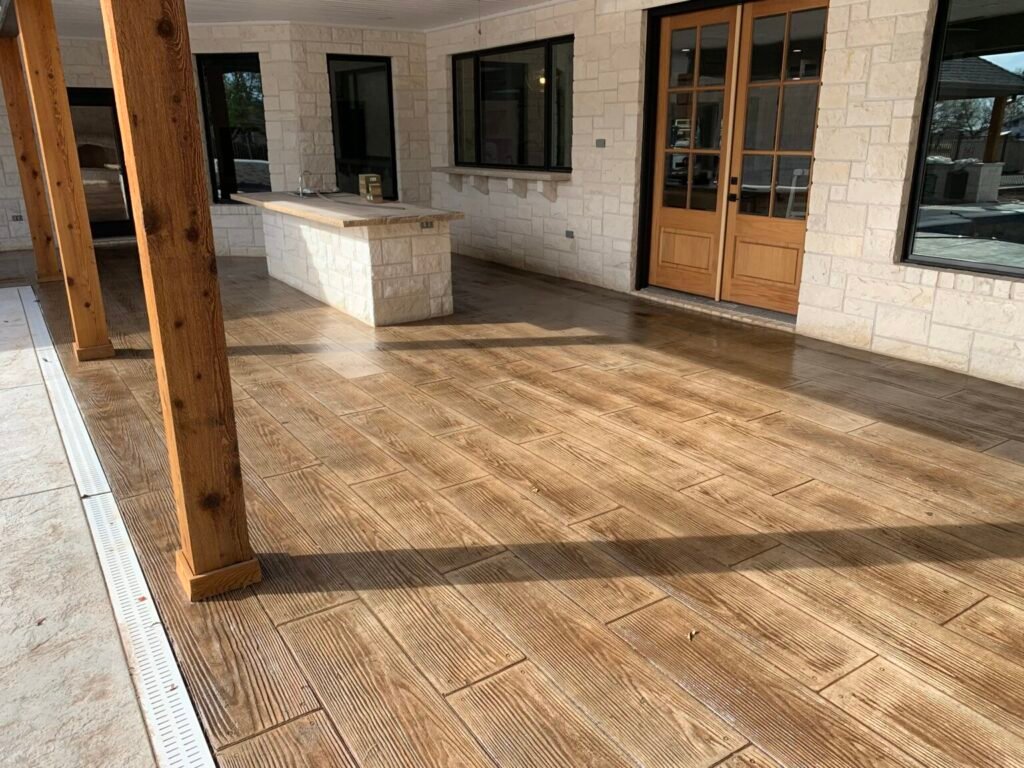Walk through any upscale neighborhood and you’ll notice something striking: the driveways, patios, and walkways that catch your eye aren’t made from traditional materials. Instead, they showcase intricate patterns and textures that rival natural stone, brick, or tile—but they’re crafted from stamped concrete.
This decorative concrete technique has quietly revolutionized how homeowners and designers approach outdoor spaces. What was once considered a purely functional material has evolved into an artistic medium that offers unlimited design possibilities at a fraction of the cost of premium materials.
The transformation isn’t just aesthetic. Stamped concrete delivers durability that outlasts many traditional paving materials while requiring minimal maintenance. For property owners seeking both beauty and practicality, this combination has proven irresistible.
The Art Behind Stamped Concrete
Stamped concrete begins as regular concrete, but the magic happens during the finishing process. While the concrete remains workable, skilled craftsmen press specialized stamps into the surface, creating detailed impressions that mimic everything from cobblestone and slate to wood planks and brick patterns.
The process requires precise timing. Wait too long, and the concrete becomes too hard to accept the pattern. Move too quickly, and the stamps may sink too deeply or leave uneven impressions. Master craftsmen understand this delicate balance, working systematically across the surface to ensure consistent depth and alignment.
Color plays an equally important role. Base colors are mixed directly into the concrete, while accent colors are applied through powder releases or liquid stains. This layered approach creates the natural color variations found in authentic materials, making it nearly impossible to distinguish quality stamped concrete from the real thing.
Beyond Aesthetics: The Practical Advantages
Durability That Lasts Decades
Properly installed stamped concrete can withstand decades of weather extremes, heavy foot traffic, and vehicle loads. Unlike pavers that can shift or develop uneven surfaces over time, stamped concrete maintains its level surface and structural integrity.
The concrete’s monolithic nature eliminates the gaps where weeds typically grow in traditional paved surfaces. This seamless construction also prevents the settling issues common with segmented materials like brick or stone pavers.
Cost-Effective Luxury
Premium natural stone can cost three to four times more than stamped concrete, yet the visual difference becomes negligible with skilled installation. This cost advantage extends beyond the initial installation—stamped concrete requires significantly less maintenance than natural materials that may need periodic re-leveling, joint sand replacement, or individual unit replacement.
Versatility in Design Applications
Stamped concrete adapts to virtually any space configuration. Curved walkways, irregularly shaped patios, and multi-level installations present no special challenges. This flexibility makes it ideal for custom designs that would be difficult or expensive to achieve with pre-manufactured materials.
Popular Stamped Concrete Patterns Reshaping Landscapes
Ashlar Slate
This pattern replicates the refined appearance of cut stone with rectangular shapes in varying sizes. The sophisticated look works particularly well for pool decks and entertaining areas where elegance is paramount.
Cobblestone
Perhaps the most popular stamped concrete pattern, cobblestone provides Old World charm with modern durability. The rounded stone appearance suits both traditional and contemporary architectural styles.
Wood Plank
Stamped concrete can convincingly replicate wood grain and plank patterns, offering the warmth of wood decking without concerns about rot, insects, or regular staining requirements.
Brick Patterns
From running bond to herringbone layouts, brick-patterned stamped concrete delivers classic appeal. The consistent color and perfect alignment often surpass what’s achievable with actual brick installations.
Installation Considerations That Impact Success
The foundation determines everything. Proper excavation, base preparation, and sub-grade compaction create the stable platform essential for long-term performance. Corners cut during these preparatory phases inevitably lead to cracking, settling, or other failures years later.
Weather conditions during installation matter significantly. Extreme temperatures, high winds, or precipitation can compromise the finishing process. Experienced contractors schedule stamped concrete projects during optimal conditions and have contingency plans for weather changes.
Sealing represents the final critical step. Quality sealers protect the surface from stains, enhance color depth, and provide UV protection that prevents fading. The sealing schedule—typically every two to three years—directly impacts the installation’s longevity and appearance.
Maintenance That Keeps Stamped Concrete Looking New
Regular cleaning with mild detergents and water handles most maintenance needs. Pressure washing can remove stubborn stains, though excessive pressure may damage the surface texture or sealer.
Resealing schedules depend on traffic levels and exposure conditions. High-traffic areas may require annual attention, while protected surfaces might extend three years between applications. The investment in regular sealing pays dividends in appearance retention and surface protection.
Minor repairs are typically straightforward. Small cracks can be filled and recolored to match the surrounding surface. This repairability gives stamped concrete a significant advantage over materials like natural stone, where matching replacement pieces can be difficult or impossible to source.
The Future of Decorative Concrete
Innovation continues to advance stamped concrete capabilities. New integral color formulations provide enhanced UV stability and color consistency. Advanced sealer technologies offer improved durability and easier application.
Digital design tools now allow homeowners to visualize different patterns and colors before installation begins. This technology reduces uncertainty and helps ensure satisfaction with the final result.
Environmental considerations are driving the development of more sustainable concrete mixes and eco-friendly sealers. These advances align with growing consumer preference for environmentally responsible building materials.
Making Stamped Concrete Work for Your Project
Stamped Concrete delivers the durability of traditional concrete while adding elegance, texture, and value to your property—making it a smart investment for both residential and commercial spaces.
To get the most from your stamped concrete project, begin with clear expectations and proper planning. Understanding the material’s strengths and limitations ensures long-term satisfaction with both appearance and performance.
Work with experienced contractors who specialize in stamped finishes. Their skill and attention to detail make a significant difference in surface quality, pattern consistency, and overall longevity. Review portfolios and speak with past clients to verify results.
When selecting patterns and colors, think long-term. Subtle, natural tones often age better and adapt to changing landscape designs, helping your property maintain a timeless and polished look.

